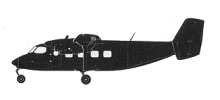Incident Overview

Description
LFH Luftverkehr Friesland Harle was engaged in scheduled operations between Prnu and Ruhnu Airport in Estonia, using BN-2 Islander aircraft. The flight that had been initially planned for 26th February 2007, was postponed several times due to adverse meteorological conditions, causing problems with provision supply on Ruhnu island. On Friday, 3rd March, pilot checked the weather at 15:00 and at 16:00. Based on the received information the pilot decided to depart for Ruhnu at 16:00. At 16:08, the aircraft took off from Prnu airport with a pilot, two passengers and 520 kg of cargo on board. According to the weather briefing received by the pilot via telephone from Kuressaare, at 16:00 the cloud height in Kuressaare (EEKE, 36 Nm northwest of Ruhnu) was 600 ft. and 180 m (approximately 540 ft.) in Ruhnu. During the uneventful flight on the altitude 1500 ft., the coast and the ice border were clearly visible. The aircraft stayed clear from the clouds and no signs of icing were noticed by persons on board. Approaching the island from the northeast it was intended by the pilot to use runway 32 for landing. The pilot decided to fly low from east to west across the runway to check the windsock and runway condition. While approaching the island, the pilot descended at the rate of 150 ft/min with low power settings and flaps extended by 1 notch. During descent the horizontal and vertical visibility deteriorated and the flight was continued in IMC. The descent was continued in clouds; therefore the pilot had no visual contact with the ground and horizon. The aircraft broke through the clouds over the coast at a very low altitude (100-120 feet). Trying to maintain safe altitude and speed pilot added power, at the same time stall warning signal activated and seconds later the lower part of aircraft’s fuselage touched the treetops and collided with the terrain at 16:36. The passengers and pilot escaped the aircraft without assistance and with no injuries. Causes of the accident: The investigation established the following causes of the accident: 1. The pilot could not maintain safe flight altitude when approaching Ruhnu aerodrome. 2. The pilot continued the descent in spite of IMC. Contributing factors to the accident The investigation established the following factors contributing to the accident: 1. High motivation to perform the flight. 2. Inadequate weather information from ground services of Ruhnu aerodrome. 3. Inadequate aeronautical oversight in the destination airport.
Primary Cause
Pilot’s failure to maintain safe flight altitude while approaching the Ruhnu aerodrome, exacerbated by inadequate weather information and oversight.Pilot’s failure to maintain safe flight altitude while approaching the Ruhnu aerodrome, exacerbated by inadequate weather information and oversight.Share on:




